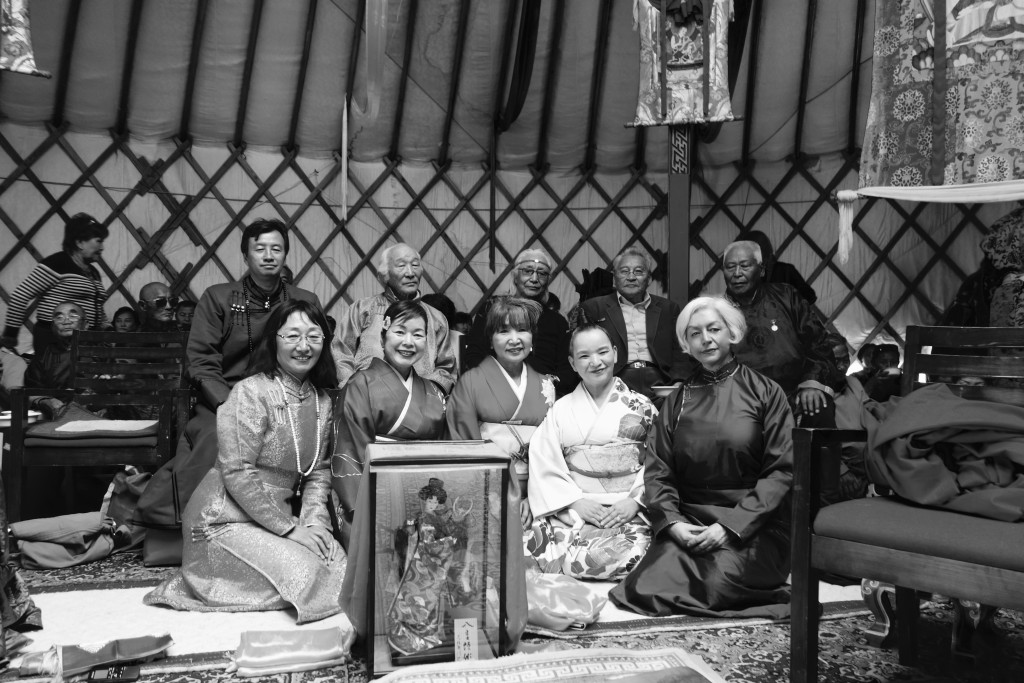The following photograph was taken by Takahata Setsuji (Lecturer in Photographic Studies, Osaka University of the Arts; Teacher of photography for the Japanese Photography and Arts Network of Centres; Member of the Japanese Professional Photographers Society and The Japanese Society for Arts and the History of Photography). It is reprinted here courtesy of the photographer.

Intercultural meeting of scholars, ethnographers, poets and designers at Delgertsogt Mountain in the Dundgovi, Mongolia. 5 September 2015.
Front row (left to right): Dr Nogun’daguula (Manchu scholar, Mongolian Literature and History Institute, Chi Feng University, China); Takahata Sachiko, Toyoto Shizuyo, Yamaguchi Toshiko; Catherine Pleteshner (Research Fellow, Nomadic and Buddhist Philosophies, Zava Damdin Institute of Mongolia). In absentia: Yadamjavyn Sumiya (Senior Secretary of the Mongolian Journal of Native Language and Script published by the Mongolian Academy of Sciences); Baikal Khuasai (Graduate research student, Department of Social and Cultural Anthropology, National University of Mongolia).
Back row (left to right): Dr. Babu (Scholar of Jebtsundampa Khutuukt [Mong. Жавзандамба хутагт], Mongol history of the Qing Dynasty and Mongol ideology; Lecturer, Mongolian Literature and History Institute, Chi Feng University China); Choisuren Dagvadorj (Mongol Scholar-Poet, Ulanbaator School of the Mongolian National University); Hatagin Gotov Akim (Journalist and Mongol historian); Professor Domii Tumurtogoo (Director of the Institute for Mongolian Studies) at the National University of Mongolia; General Secretary of the International Association of Mongolian Studies (IAMS); foundation member of the Mongolian National Council of Mongolian Studies; and Convenor of the Mongolian Kangyur and Tengyur Scholars’ Council); Sosorbaram (Senior academic at the Mongolian University of Life Sciences in Ulanbaator, one of Mongolia’s famous wrestling ‘Lions’ during the 1960s and a well-known local lineage-holder of traditional Gobi Long Song).
The above photograph was taken after the finale of an afternoon-long concert of traditional Mongolian singing, dancing, morin khuur and other performances kindly arranged by E. Sonintogos (Director since 2010) of the Mongolian State University of Arts and Culture (MSUAC). Faculty vocal instructors and musicians from the University as well as other entertainers not affiliated with MSUAC (such as the Director of the Newstar Music Studio in Ulanbaator) thrilled an appreciative audience with their artistic performances and technical expertise. Zagdochir (MSUAC’s Humii Teacher) not only performed, but was the very competent and entertaining Master of Ceremonies on the day.
From my own ethnographic and ‘social network theory’ perspective, the above affinity group can also be seen as a noteworthy example of one of many such ‘loosely connected’[1] social sub-groups who contributed to the day. In more technical terms, the ‘locally anchored’ (to Mongolia) ‘interest-based’ (Mongol, Buddhist, culture and society) ‘work cluster’ (exchange of academic discourse and books) can also be seen as a successful example of one of the many ‘informal economic forms that have evolved in Mongolia since 1990’ [2] that endow their active host-contributors, ‘with a sense of avoiding the worst pitfalls of the transition’ in Mongolia: through post-soviet socialism and now on to unrealised possibilities of what could reasonably be considered to come next.
It seems to me, that people who perceive themselves as potentially vulnerable to unpredictable external forces—economic, social, geo-political, whatever they may be—at times (and in response to such ‘ontological insecurity’ (see Kinnvall, C. (2004). Globalisation and Religious Nationalism: Self, Identity, and the Search for Ontological Security Political Psychology 25(5): 741-767) are drawn to co-inhabit ‘closed networks of weak connections.’[3] In terms of better understanding contemporary Mongol society and also facilitating local Mongol-led ethnographic research practice, such ‘inter-connectedness’ of Mongolians-in-Mongolia to others may well be realised as a critical determinant of their individual ‘transitional’ success.
To illustrate this point within a higher education framework with which I am more familiar, at least three scholars in the above group (that I am aware of) already have ‘weak tie’ connections (albeit different) to other scholars of Mongolian society, literature and culture in Australia. Professor Li Narangoa and other Australian National University-auspiced scholars and students at the Mongolian Studies Centre in Canberra (in collaboration with the Embassy of Mongolia) are an example of another affinity group ‘node’ of which I speak. I suppose that in terms of Kalish and Robins’ (2006) social network theorising within a globalising social context, my own small contribution here could be seen as that of bridging the perceived ‘structural holes’ between potentially ‘strong tie’ partners, some of whom may otherwise have remained separated, but not all.
[1] Granovetter, Mark S. (1973) The Strength of Weak Ties American Journal of Sociology 78(6): 1360-1380.
[2] Pedersen, M. A. and L. Hojer (2008). Lost in Transition: fuzzy property and leaky selves in Ulanbaator. Ethnos 73(1): 73-96, p74.
[3] Kalish, Y and G Robins (2006) Psychological predispositions and network structure: The relationship between individual predispositions, structural holes and network closure. Social Networks 28: 56-84, p56.
Attribution
In keeping with ethical scholarly research and publishing practices and the Creative Commons Attribution 4.0 International License, I anticipate that anyone replicating the photographs or translating into another language all or part of this article and submitting it for accreditation or other purpose under their own name, to acknowledge this URL and its author as the source. Not to do so, is contrary to the ethical principles of the Creative Commons license as it applies to the public domain.
end of transcript.
Refer to the INDEX for other articles that may be of interest.
© 2013-2025. CP in Mongolia. This post is licensed under the Creative Commons Attribution 4.0 International License. Documents linked from this page may be subject to other restrictions. Posted: 6 October 2015. Last updated: 29 October 2017.